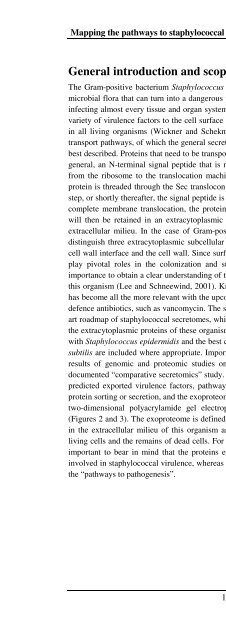The Staphylococcus aureus secretome - TI Pharma
The Staphylococcus aureus secretome - TI Pharma
The Staphylococcus aureus secretome - TI Pharma
You also want an ePaper? Increase the reach of your titles
YUMPU automatically turns print PDFs into web optimized ePapers that Google loves.
Mapping the pathways to staphylococcal pathogenesis by comparative secretomics<br />
General introduction and scope of this review<br />
<strong>The</strong> Gram-positive bacterium <strong>Staphylococcus</strong> <strong>aureus</strong> is a frequent component of the human<br />
microbial flora that can turn into a dangerous pathogen. As such, this organism is capable of<br />
infecting almost every tissue and organ system in the human body. It does so by exporting a<br />
variety of virulence factors to the cell surface and extracellular milieu of the human host. As<br />
in all living organisms (Wickner and Schekman, 2005), S. <strong>aureus</strong> contains several protein<br />
transport pathways, of which the general secretory (Sec) pathway is the most well known and<br />
best described. Proteins that need to be transported to an extracytoplasmic location contain, in<br />
general, an N-terminal signal peptide that is needed to target the newly synthesized protein<br />
from the ribosome to the translocation machinery in the cytoplasmic membrane. Next, the<br />
protein is threaded through the Sec translocon in an unfolded state. During this translocation<br />
step, or shortly thereafter, the signal peptide is removed by a so-called signal peptidase. Upon<br />
complete membrane translocation, the protein has to fold into its correct conformation and<br />
will then be retained in an extracytoplasmic compartment of the cell, or secreted into the<br />
extracellular milieu. In the case of Gram-positive cocci, such as S. <strong>aureus</strong> (Figure 1), we<br />
distinguish three extracytoplasmic subcellular compartments: the membrane, the membranecell<br />
wall interface and the cell wall. Since surface-exposed and secreted proteins of S. <strong>aureus</strong><br />
play pivotal roles in the colonization and subversion of the human host, it is of major<br />
importance to obtain a clear understanding of the protein transport pathways that are active in<br />
this organism (Lee and Schneewind, 2001). Knowledge about the protein sorting mechanism<br />
has become all the more relevant with the upcoming of staphylococcal resistance against lastdefence<br />
antibiotics, such as vancomycin. <strong>The</strong> scope of this review is to provide a state-of-theart<br />
roadmap of staphylococcal <strong>secretome</strong>s, which include both protein transport pathways and<br />
the extracytoplasmic proteins of these organisms. <strong>The</strong> focus is on S. <strong>aureus</strong>, but comparisons<br />
with <strong>Staphylococcus</strong> epidermidis and the best characterized Gram-positive bacterium Bacillus<br />
subtilis are included where appropriate. Importantly, the present review aims to integrate the<br />
results of genomic and proteomic studies on S. <strong>aureus</strong> <strong>secretome</strong>s, representing the first<br />
documented “comparative secretomics” study. Specifically, this review deals with known and<br />
predicted exported virulence factors, pathways for protein transport, signals for subcellular<br />
protein sorting or secretion, and the exoproteomes of different S. <strong>aureus</strong> isolates as defined by<br />
two-dimensional polyacrylamide gel electrophoresis (2D-PAGE) and mass spectrometry<br />
(Figures 2 and 3). <strong>The</strong> exoproteome is defined by all S. <strong>aureus</strong> proteins that can be identified<br />
in the extracellular milieu of this organism and thus includes proteins actively secreted by<br />
living cells and the remains of dead cells. For a clear appreciation of the present review, it is<br />
important to bear in mind that the proteins exported from the cytoplasm could be directly<br />
involved in staphylococcal virulence, whereas the respective protein export systems represent<br />
the “pathways to pathogenesis”.<br />
17













